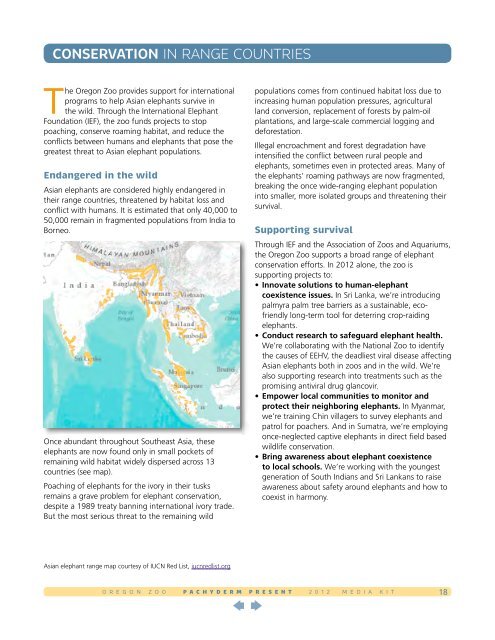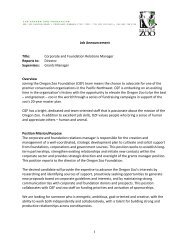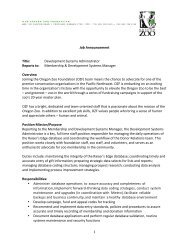You also want an ePaper? Increase the reach of your titles
YUMPU automatically turns print PDFs into web optimized ePapers that Google loves.
Conservation in Range Countries<br />
The <strong>Oregon</strong> <strong>Zoo</strong> provides support for international<br />
programs to help Asian elephants survive in<br />
the wild. Through the International <strong>Elephant</strong><br />
Foundation (IEF), the zoo funds projects to stop<br />
poaching, conserve roaming habitat, and reduce the<br />
conflicts between humans and elephants that pose the<br />
greatest threat to Asian elephant populations.<br />
Endangered in the wild<br />
Asian elephants are considered highly endangered in<br />
their range countries, threatened by habitat loss and<br />
conflict with humans. It is estimated that only 40,000 to<br />
50,000 remain in fragmented populations from India to<br />
Borneo.<br />
Once abundant throughout Southeast Asia, these<br />
elephants are now found only in small pockets of<br />
remaining wild habitat widely dispersed across 13<br />
countries (see map).<br />
Poaching of elephants for the ivory in their tusks<br />
remains a grave problem for elephant conservation,<br />
despite a 1989 treaty banning international ivory trade.<br />
But the most serious threat to the remaining wild<br />
populations comes from continued habitat loss due to<br />
increasing human population pressures, agricultural<br />
land conversion, replacement of forests by palm-oil<br />
plantations, and large-scale commercial logging and<br />
deforestation.<br />
Illegal encroachment and forest degradation have<br />
intensified the conflict between rural people and<br />
elephants, sometimes even in protected areas. Many of<br />
the elephants’ roaming pathways are now fragmented,<br />
breaking the once wide-ranging elephant population<br />
into smaller, more isolated groups and threatening their<br />
survival.<br />
Supporting survival<br />
Through IEF and the Association of <strong>Zoo</strong>s and Aquariums,<br />
the <strong>Oregon</strong> <strong>Zoo</strong> supports a broad range of elephant<br />
conservation efforts. In 2012 alone, the zoo is<br />
supporting projects to:<br />
• Innovate solutions to human-elephant<br />
coexistence issues. In Sri Lanka, we’re introducing<br />
palmyra palm tree barriers as a sustainable, ecofriendly<br />
long-term tool for deterring crop-raiding<br />
elephants.<br />
• Conduct research to safeguard elephant health.<br />
We’re collaborating with the National <strong>Zoo</strong> to identify<br />
the causes of EEHV, the deadliest viral disease affecting<br />
Asian elephants both in zoos and in the wild. We’re<br />
also supporting research into treatments such as the<br />
promising antiviral drug glancovir.<br />
• Empower local communities to monitor and<br />
protect their neighboring elephants. In Myanmar,<br />
we’re training Chin villagers to survey elephants and<br />
patrol for poachers. And in Sumatra, we’re employing<br />
once-neglected captive elephants in direct field based<br />
wildlife conservation.<br />
• Bring awareness about elephant coexistence<br />
to local schools. We’re working with the youngest<br />
generation of South Indians and Sri Lankans to raise<br />
awareness about safety around elephants and how to<br />
coexist in harmony.<br />
Asian elephant range map courtesy of IUCN Red List, iucnredlist.org<br />
O R E G O N Z O O P A C h y d e r m P r e s e n t 2 0 1 2 M E D I A K I T<br />
18

















